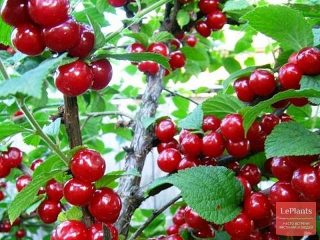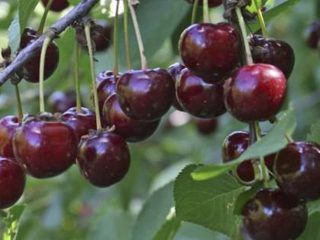Content
Dwarf cherries are compact in size and produce a high, decent harvest. One of the best is the Vstrecha variety, which bears tasty fruits and has high immunity.
History of selection
Cherry Vstrecha was bred by Ukrainian breeders Nikolai and Valentina Turovtsev. When working on it, the cherry-cherry hybrid Kyiv-19 and late-ripening Lyubskaya cherry were used.
The hybrid was produced in 1966. Since 1995, information about the Meeting has been present in the state register of varieties of Ukraine.
Description of culture
Features of the hybrid Meeting:
- bush type tree;
- height from 2 to 2.5 m;
- wide dense crown in the shape of a ball;
- drooping shoots.
The Vstrecha variety is a natural dwarf. The advantages of dwarf varieties are compactness, easy care and high yield. The cherry bush has a lush crown, quickly takes root and grows after planting.
Characteristics of fruits of the Vstrecha variety:
- large sizes;
- weight 15 g;
- round, slightly flattened shape;
- thin burgundy skin;
- juicy and tender red flesh;
- medium sized bone.
The fruits have a dessert taste. One of the parent varieties is a hybrid of cherry and black cherry, so the taste contains cherry notes. Taste qualities are rated 5 out of 5.
Cherry pulp has a high sugar content (11.6%). In terms of marketability and taste, the fruits are close to the standard varieties Chudo and Shokoladnitsa.
The Vstrecha variety is recommended for planting in steppe regions. In temperate and cool climates, the tree develops slowly and does not bear fruit.
Characteristics
When choosing cherries, take into account its resistance to drought, frost, diseases and pests. If necessary, select a pollinator variety.
Drought resistance, winter hardiness
Hybrid Vstrecha has good drought resistance and can tolerate lack of moisture. To increase productivity, it is recommended to water the tree during flowering and at the beginning of fruiting.
The winter hardiness of the Vstrecha variety is quite low. The tree tolerates winter frosts down to – 25 °C.
Pollination, flowering period and ripening time
The Vstrecha variety blooms at the end of April or beginning of May. The variety is partially self-fertile. To obtain a high yield, pollinator planting is required.
The best pollinators for the Vstrecha hybrid are dwarf varieties that bloom at the same time. Planted next to a tree Lyubskaya cherry, Noticeable, Samsonovka, Minx.
Harvesting begins at the end of June. The fruits remain on the branches for a long time after ripening.
Productivity, fruiting
Fruiting of the Vstrecha variety begins 3-4 years after planting the seedling. The harvest ripens on one-year-old shoots.
The yield of the variety is high - about 25 kg of fruits per bush. Fruiting is stable from year to year. The average lifespan of a tree is 20 years, after which the plantings are replaced.
Area of application of berries
Due to its dessert taste, Vstrecha cherry is suitable for fresh consumption and making desserts. The fruits tolerate transportation and freezing well. A variety of homemade preparations are obtained from it: jam, compotes, juices, marshmallows.
Resistance to diseases and pests
Cherry resistance to diseases and pests is assessed at an average level. The tree is immune to moniliosis and coccomycosis.
A mandatory stage of care is carrying out preventive treatments. Fungal diseases that spread in high humidity are especially dangerous for wood.
Advantages and disadvantages
The main advantages of the Meeting cherry:
- high productivity;
- easy care due to the low growth of cherries;
- quickly begins to bear fruit;
- commercial and taste qualities of fruits.
The disadvantages of the Vstrecha variety include:
- the need to plant a pollinator;
- average frost resistance;
- demands on climatic conditions.
Landing Features
The cherries are planted in the prepared area. Be sure to take into account the composition of the soil and crops growing in close proximity to the hybrid.
Recommended timing
The period from mid-September to October is suitable for planting. When planted in autumn, the cherries will have time to take root before the onset of cold weather.
It is allowed to postpone planting work to spring (mid-April or early May). Planting begins after the soil warms up, but before the buds swell.
Choosing a suitable location
The place for growing cherries must meet a number of requirements:
- good lighting;
- absence of wind loads;
- drained fertile soil.
Cherry prefers flat areas where its roots are not exposed to moisture. Therefore, lowlands and slopes are not suitable for planting.
Light, fertile soil is best suited for planting: loam or sandstone of neutral reaction. Lime is added to the acidified soil 2-3 weeks before the work is carried out.
What crops can and cannot be planted next to cherries?
Hybrid Meeting tolerates the proximity of other varieties of cherries and various shrubs well:
- cherries;
- sloe, plum, cherry plum;
- grape;
- elder;
- hawthorn;
- honeysuckle;
- Rowan.
The exceptions are sea buckthorn, gooseberries, raspberries and currants. The hybrid is removed from other shrubs by 1.5-2 m.
Vstrecha cherry is planted away from the following crops:
- apple tree, pear tree;
- peach, apricot;
- oak, maple, linden, birch;
- coniferous trees;
- tomato, pepper and other nightshades.
Tall trees create shade, and their roots take a lot of nutrients from the soil. The permissible distance between cherry and other trees is from 5 to 6 m.
Selection and preparation of planting material
For planting, choose two-year-old seedlings with a height of 50-60 cm. The seedling must have healthy roots and shoots without damage.
4 hours before the start of work, the roots of the seedling are immersed in clean water, to which a root growth stimulator is added.
Landing algorithm
The sequence of work for planting the Vstrecha variety:
- The soil in the selected area is dug up.
- Then prepare a pit measuring 50 cm and depth 40 cm.
- The pit is left for 3-4 weeks to allow the soil to shrink. For spring planting, it is better to prepare the hole in the fall.
- Add to the fertile soil: 50 g of superphosphate, 30 g of potassium sulfate and 1 kg of wood ash.The components are thoroughly mixed, part of the soil is placed in the hole.
- The cherry tree is planted in a hole, its roots are straightened and covered with the remaining soil.
- The soil is well compacted.
- The seedling is watered abundantly.
Subsequent care of the crop
Dwarf cherry trees are pruned before or after the start of sap flow. For each bush, 5-10 of the strongest shoots are left. Be sure to remove dry, broken and frozen branches.
Hybrid Meeting is enough to water 3-5 times per season. The shrub requires moisture at the flowering stage and at the beginning of fruiting. 2-3 liters of water are poured under the bush.
To prepare the Vstrecha cherry for winter, its trunks are hilled up and the soil is mulched with humus. The young seedling is covered with a net or roofing felt to protect it from rodents, and in winter a snowdrift is placed on top.
Diseases and pests, methods of control and prevention
Despite the resistance of the hybrid Meeting to diseases, under certain conditions signs of damage may appear on the tree.
Common diseases to which cherries are susceptible are shown in the table:
Disease | Symptoms | Control measures | Prevention |
Moniliosis | First, the cherry shoots and leaves dry out. Then gray growths appear and the fruits rot. | The affected parts of the tree are cut off and destroyed. Cherries are sprayed with Bordeaux mixture or Cuprozan. |
|
Cocomycosis | The appearance of round brown spots on the leaves. As a result, the leaves fall and the bush dies. | Spraying with Bordeaux mixture or copper oxychloride. | |
Anthracnose | Brown spots on the surface of fruits that grow rapidly. | Removing the affected fruits and spraying the bush with Poliram. |
The table shows the main cherry pests:
Pest | Signs of defeat | Control measures | Prevention |
Aphid | It feeds on the juice of young leaves. The pest is identified by curled leaves. | Spraying with solutions of Phosfamide or Fitoverm. |
|
Weevil | Eats ovaries and gnaws holes in leaves. | Spraying with insecticides Fufanon, Actellik. | |
Sawfly | The larvae eat the top layer of leaves, which begin to fall off. | Spraying with Kemifos. |
Conclusion
Hybrid Vstrecha tolerates hot climate conditions well. The variety is distinguished by high yield and dessert taste of fruits.
Reviews













